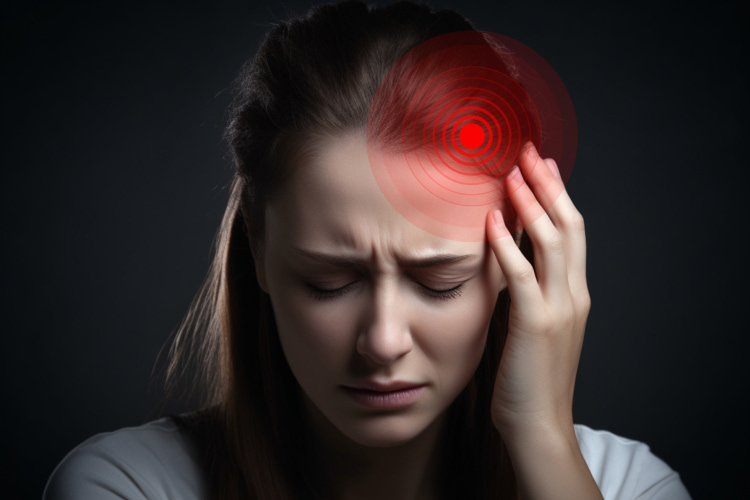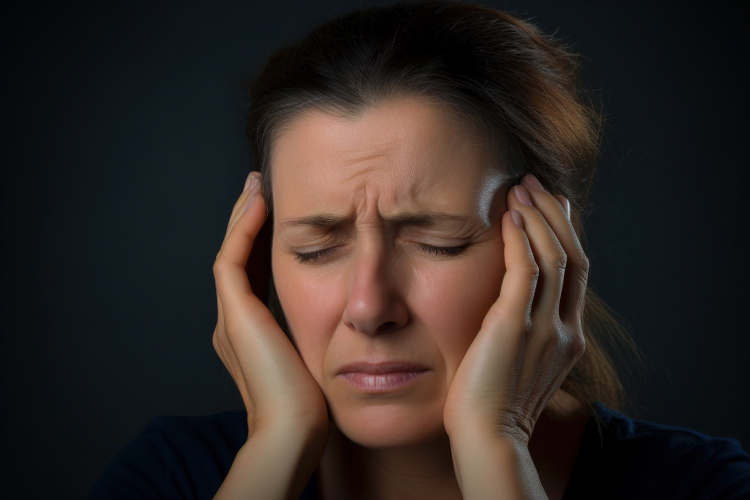In the puzzle of everyday life, nothing disrupts the picture quite like a constant migraine. These throbbing headaches that won’t let up can be genuinely perplexing. But fear not, for we are on a journey through the causes of constant migraines. We want to get to the bottom of migraines and understand the insidious triggers that set them in motion.
Imagine that your brain is like a busy control center. And it’s subject to a variety of factors. All of these factors can cause it to become confused. From the food on your plate to the stress in your head. These migraine triggers can act as mischievous troublemakers. They trigger a migraine when you least expect it.
In this study, we’ll trace the pathways of caffeine, stress, sleep, etc., to piece together the tangled web of factors contributing to your head’s constant throbbing. So, fasten your seatbelts. We’re going to take a journey through the maze of constant migraines. We’ll shed light on the shadows cast by unsuspecting triggers.
What Causes Constant Migraines?
Persistent migraines can be an unwanted and constant companion. These throbbing headaches often come along with nausea and sensitivity to light. There are different triggers of migraines. Understanding their possible causes is crucial. It will help eliminate and prevent recurring discomfort. Factors that contribute to persistent migraines include:
- Genetics. A family history of migraines can increase the likelihood of having them regularly.
- Hormonal changes. Fluctuating estrogen levels can trigger migraines.
- Environmental triggers. Certain irritants can trigger migraines. These can be bright lights, strong odors, or loud noises.
- Stress. Emotional or physical stress is a common migraine trigger.
- Sleep regimen. Irregular sleep patterns may contribute to the development of chronic migraine.
- Dietary factors. Certain foods and beverages can be migraine triggers. These can include caffeine, chocolate, and aged cheeses.
- Dehydration. Not drinking enough water can lead to migraines.
Knowing what causes constant migraines can be a crucial step. It will help in the effective treatment of persistent migraines.

Stages of a Migraine
Embarking on the rollercoaster journey of a migraine isn’t just a simple ascent and descent. Instead, it unfolds in distinct stages, each with its symptoms and challenges. Understanding these stages is like decoding the language of your headache. It provides insight into why migraines are more than just a one-size-fits-all experience.
Imagine a migraine as a story, with its beginning, middle, and end. The stages – prodrome, aura, headache, and postdrome – are like chapters. Each contributes to the narrative in its unique way. These stages aren’t arbitrary. They showcase the intricate dance of neurological and vascular changes in your brain. The prodrome may serve as a subtle prelude, signaling the impending storm, while the aura can be seen as a visual or sensory overture.
So, why these stages? They unfold due to the complex interplay of genetics and brain chemistry. By peeling back the layers of each stage, we gain a deeper understanding of the common triggers of migraines. It helps us navigate its twists and turns with greater clarity.
Prodrome
The prodromal stage of a migraine is like the subtle whisper before the storm. It is your body warning you that constant migraine symptoms are approaching. During this stage, you may notice changes such as mood swings, fatigue, or food cravings. It is a mild jolt, a precursor to the main event. It gives you a chance to prepare for the impending headache.
Aura
The aura stage of a migraine is like a brief, surreal detour. It causes temporary sensory disturbances, such as flickering lights or zigzag lines in the field of vision. Some people experience tingling or numbness. It is a visual and sensory prelude to an impending headache. It gives a distinct character to the feeling of the migraine before the pain comes to the forefront.
Attack
The attack stage of a migraine is when the pain steals the spotlight. Pounding, throbbing, and often one-sided, the headache can be intense. Accompanying symptoms may include nausea and sensitivity to light and sound. It’s the peak of the migraine experience, demanding attention and often forcing a pause in daily activities. It is the stage where the discomfort reaches its zenith before gradually subsiding.
Post-drome
The postdrome stage of a migraine is like the aftermath of a storm, where the calm settles in. After the intense headache, you may feel drained, fatigued, and mentally foggy. It’s a recovery period akin to a gentle return to normalcy. Some people might experience a sense of relief, while others may need a bit more time to bounce back fully, marking the end of the migraine journey.

Migraine Triggers List
Do you want to beat migraines? Then, first of all, you need to solve the riddle of causes of frequent migraines. These are the causes that can trigger unwanted headaches.
Think of it as your map of the maze of migraine triggers. It’s a comprehensive guide to help you navigate the twists and turns. Understanding your triggers is the key to a headache-free life. From the foods on your plate to the stress of the day. These triggers can be elusive troublemakers that often sneak up unnoticed.
Below, we invite you to review a detailed list of these potential culprits. We want to shed light on the various factors that can contribute to headaches. Let’s unravel the mystery of migraine thrillers together. You can take control of yourself and minimize these throbbing disturbances in your daily life.
Some factors from the migraine triggers list we have already reviewed above. But we suggest looking at these factors in more detail for a deeper understanding.
Dietary Factors
Certain foods can be like the “silent architects” of migraine. From aged cheese to processed meats, these food factors are key in triggering pain. Chocolate, caffeine, and even some additives can be culprits. Thus, controlling what is on your plate can be a strategic move. It will ensure success in the fight against migraine.
Environmental Factors
Your environment can be your secret ally or enemy in the migraine saga. These environmental factors include bright lights, loud noises, and strong odors. These are the common triggers of migraines that can trigger attacks. Weather changes can also join the migraine-inducing ensemble. Understanding and managing these environmental triggers can be crucial in creating a headache-friendly space that provides some relief in the face of potential attacks.
Hormonal Changes
Hormonal changes can be like a backstage conductor influencing the migraine orchestra. For many, fluctuations in estrogen levels can act as silent triggers. It can be during menstruation or pregnancy. These hormonal shifts might set the stage for headaches, playing a role in the migraine drama. Understanding the ebb of hormones can offer insights into managing and mitigating the impact.
Stress and Emotional Factors
Stress and emotion often play a role in chronic daily headaches. Are stress levels rising, or are emotions running high? Then, headaches can follow. Tension, anxiety, and even excitement can be triggers. These will contribute to the throbbing discomfort. We recommend that you learn how to manage stress with relaxation techniques. It will be an extremely important tool in your migraine management arsenal. It will reduce your level of emotional triggers.
Medications
Surprisingly, medications meant to bring relief can sometimes be dual agents. Yes, some medications can cause headaches as a Side Effect. The most common is a medication that dilates blood vessels. Overuse of painkillers can also be a cause of constant migraines. It’s a delicate balance to seek relief without triggering a migraine. Understanding medication nuances helps bridge the fine line between relief and triggers.
Physical Factors
Physical factors can be the “silent architects” of migraine. Poor posture and neck and shoulder tension can cause throbbing discomfort. We recommend being attentive to your body’s signals. It can help minimize physical triggers and relieve migraines.
Conclusion
Knowledge is your shield in the complex dance with migraine. We recommend learning about potential triggers and minimizing them. Take responsibility for your well-being. And if you are not feeling well, contact All Injury Rehab.
Remember, seeking professional help is not a sign of weakness but a smart move. Follow preventative measures and seek medical help promptly. It is how you begin the journey to a headache-free life. Your well-being deserves such proactive care.
FAQ
What’s the difference between a regular headache and a migraine?
A migraine is a severe throbbing pain, often accompanied by nausea and sensitivity to light. A regular headache, on the other hand, is milder and does not have these features.
Are there any treatments to prevent migraines?
Of course, some prevention methods include medications, lifestyle changes, and avoiding triggers. Beta-blockers and Botox injections can also help prevent migraines.
Are migraines hereditary?
Yes, migraines can be hereditary, with a family history of migraines making them more likely to occur.


Related posts
Today is an era dominated by digital conveniences and desk-bound occupations. So, the effects of a sedentary lifestyle have emerged as a pervasive concern.
Our guide aims to equip people with the knowledge to understand the intricacies of internal injuries. They are arising as a result of car accidents. Join us on this informative trip.
Beyond merely treating injuries, chiropractors work to enhance the body's biomechanics. It allows sportsmen to move more potently and reduces the risk of future injuries.